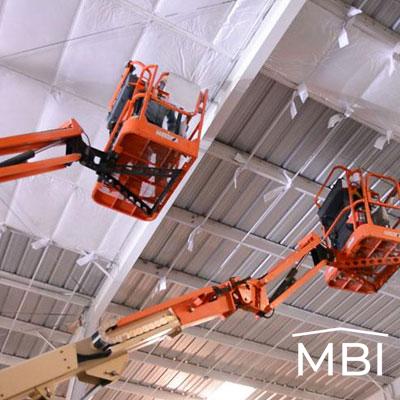Retrofit Existing Metal Buildings
Leveraging our 40 years of expertise in retrofitting existing metal buildings, we specialize in simplifying the process of selecting the ideal insulation solution for your needs.
Leveraging our 40 years of expertise in retrofitting existing metal buildings, we specialize in simplifying the process of selecting the ideal insulation solution for your needs.

Metal buildings that are not properly insulated or buildings that have old or torn insulation can contribute to condensation problems and thermal energy loss. Retrofit Existing Metal Buildings between purlins or wall girts not only save on energy bills but also addresses any existing condensation issues.
Over 50% of all metal building insulation projects are retrofit applications. Retrofitting insulation in existing metal buildings with new insulation will help to seal air leaks and improve energy efficiency. Adding new insulation will add additional R-value which saves energy and money in the long run.
We supply pre-cut insulation rolls to fit within the purlin and girt spaces of your existing metal building. After the insulation is cut to your specific measurements, facing materials are applied to insulation blankets to serve as a vapor retarder. Facing material offers a clean finished look in any metal building environment. There are several options to choose from.
- Adding insulation to an existing building will help to seal air leaks
- Increases the R-value/thickness of insulation
- Increases the energy efficiency of your building and reduces energy costs
- Improves condensation control
- Tax-saving benefits when you add insulation to your building
- Increases the lighting efficiency by providing a bright reflective surface on the walls and/or roof
- Improves interior appearance of walls and/or roof
Typically the first girt is 7’4” above the floor with the upper girt spacing being 6’ or less. In this application the insulation between the 7′ 4″ girt is installed vertically. Above that the insulation is installed horizontally. A base angle should be installed on the floor of the perimeter of the insulated area. This will provide an attachment point for the facing as well as help seal the bottom and provide a moisture barrier. When the upper girts are less than 6′, the insulation rolls are factory pre-cut to the proper size then laminated to the fiberglass and labeled accordingly. In some instances the first girt is not 7′ 4″ and all girts are 6′ or less. All insulation is installed horizontally in this case.
Stick pins can be applied to a clean steel surface with glue to hang the blankets. Once the insulation is installed over a stick pin, a friction washer is placed over the pin to keep the insulation in place. The pointed pin tips are then cut off with a wire cutter. This application gives you a quilted look.
Insulhold Coils are ideal in retrofit projects to help hold insulation in place and from sagging. Arrows, which are contoured for strength, stick within the fiberglass and provide holding power to the insulation. InsulHold bands are used independently, however, for additional support steel banding, steel liner panel, or an insulation fabric covering such as Energy Saver are optional.
Typically, metal building purlins are spaced 5’ apart. 5’ fiberglass blankets are standard. Anything other than 5’ wide can be factory pre-cut to fit the existing purlin spacing prior to lamination. The factory pre-cut roll length is then determined by the spacing of the bays or the distance between the rigid frames. The purlin depth varies with 8” being the most common. All rolls are cut, and then labeled to help ensure that the blankets are placed in the proper space.
The most common method of adding insulation to a metal building roof is with a banding system. Steel bands, typically 1” wide (depending on the manufacturer) are screwed to the under side of the metal purlin 30” apart creating a grid system in the roof. The factory pre-cut rolls are then fed through, above the steel bands, and secured. The steel bands act as a support to the fiberglass blankets.
Refacing insulation materials can give your metal building a brand-new look and improve thermal performance. To achieve this, you can choose to cover the old facing with new-facing materials or add a new layer of fiberglass with new-facing materials attached. Applying a new layer of insulation will also increase the r-value while giving your building’s interior a clean, new look and feel.

Metal Building Insulation
Littleton, CO
303-867-1179
[email protected]
